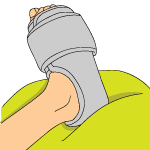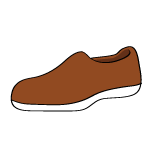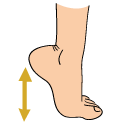We’ve already gone over the Plantar Fasciitis treatments you should avoid in our Plantar Fasciitis Myths posts, so now it’s time for the treatments that are actually effective.
 Rest
Rest
If you have Plantar Fasciitis, one of the most important things you can do is rest your foot. This can mean trying to keep the weight off your foot by resting it throughout the day or during downtime. It can also mean using crutches to keep the weight off your affected foot altogether. You should also avoid any activities that put excess strain on your foot.
 Cold Compression
Cold Compression
Icing your foot is an effective reliever of the pain and swelling that comes with Plantar Fasciitis. Applying compression helps to alleviate inflammation. We recommend that you use a cold compression wrap designed for the foot for the best treatment possible. Elevating your foot will work to further bring down any inflammation.
 Optimal Blood Flow
Optimal Blood Flow
When you have Plantar Fasciitis, blood flow to the injured plantar tissue is severely impaired. While physical activity will promote additional blood flow, it can also lead to re-injury. There are blood flow stimulation devices now on the market that can be used to bring additional blood flow to your injured plantar fascia while you are at rest. This will work to speed up the healing process and repair your damaged plantar fascia. Blood flow devices are also effective in helping to prevent re-injury.
Proper Footwear 
Wearing the correct shoes makes a huge difference when treating Plantar Fasciitis. Make sure your shoes have proper support in the heel and ball (Metatarsal) areas, as these are the areas of your foot that are designed to balance your weight and withstand the pressure of your footfalls. Avoid wearing high heeled shoes or shoes that don’t fit properly (too tight or too loose). Consider wearing slippers around the house as opposed to socks or bare feet, as this will add some cushioning between the floor and your feet.
 Exercises
Exercises
Doing the right exercises at the correct time in your recovery can be essential to healing. We recommend exercises that focus more on the muscles surrounding the plantar fascia than the plantar fascia itself. Exercises designed to “stretch” the plantar fascia do more harm than good. Please be aware that you should not do any Plantar Fasciitis exercises until you are several weeks into the healing process. Exercises for Plantar Fasciitis that we recommend include Marble Pick-Ups, Towel Scrunches, Ankle Rolls and Single Leg Standing.
Physiotherapy
Like with exercises, physiotherapy should not take place until you are already several weeks into the healing process. A physiotherapist can help to restore strength to the affected foot and improve your range of motion through exercise. Physical therapy doesn’t just mean exercises though. It can also include treatment methods like taping, cold compression and blood flow stimulation.
 NSAIDs and Analgesics
NSAIDs and Analgesics
NSAIDs (non-steroidal anti-inflammatory medications) such as Advil and Aleve and analgesics such as Tylenol can be used to temporarily relieve the pain. An added benefit of NSAIDs is the fact that they also work to relieve inflammation, whereas analgesics do not. If you’re going to take painkillers, make sure you take them during times of rest. Do not use painkillers if you plan on being active or on your feet for long periods of time. Painkillers mask the pain, which can cause you to feel a false sense of ability. This can sometimes make people overdo it physically, leading to re-injury because they can’t feel the damage they’re doing to their foot.